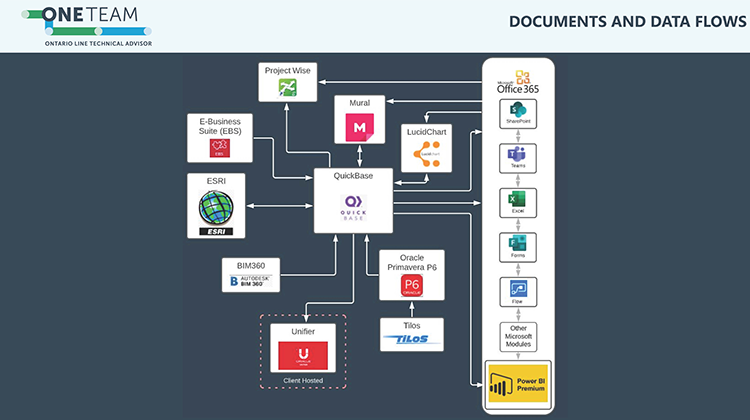
Experts Talk: Integrated Project Management Information Systems with Brad Robinson and Brandon Joy
Experts Talk is an interview series with technical leaders from across our transportation program.
How New Applications Like QuickBase Affordably Reach Across Platforms to Deliver Integrated Data Dashboards
Time, quality, money — these make up the three-legged-stool upon which project success sits from start to finish.
Often we don’t have information on these legs at our fingertips that’s vital for decision-making, but new software tools help us reach across platforms to go to one place — a single source of truth. This gives us time to focus on delivering the project rather than spending time digging for data.
Brad Robinson, our director of project controls, advocates processes and software that lead to project efficiency by implementing project management information system tools, or PMIS. Brandon Joy, our commercial management director, focuses on commercial aspects of our projects to mitigate risk, satisfy clients, and deliver successful projects.
In this installment of Experts Talk they discuss how we are leveraging new tools and workflows to streamline the development of project dashboards and to implement PMIS tools that help project leaders better deliver infrastructure.
Q. You’ve had some recent success rolling out PMIS on huge programs that integrate with existing systems. Can you describe an example?
Robinson: A great example is our work on the CA$10 billion-plus Ontario Line subway project in Toronto. For such a massive project, up-to-the-minute and accurate data is essential. We use QuickBase as our central source of data; it’s a no-code platform that you can think of as sitting on top of existing owner and project information systems. It lets us view and connect project and progress-related data across multiple programs and processes, keeping the team’s more than 1,000 members connected. It’s a huge improvement over older tools that required pulling data into slower, labor-intensive spreadsheets that don’t provide real-time status.

Q. How has this helped the owner deliver their infrastructure program?
Joy: It’s real time. Projects often have a significant amount of information that the team needs to keep up with, and often information comes from different systems such as from a Primavera schedule combined with an accounting system cost report. For our internal project management purposes we realized we needed to pull information together from various systems into a common platform to improve real-time management. It has worked so well for us internally that we have started providing similar systems as a service for clients to leverage those same benefits.
For a reasonably low cost we develop a single source of truth — a data hub that includes workflow and notifications — that gets the project up and running quickly. Some black-box solutions can take a year to get modules going; we can be up and going in a fraction of that time with our own people who understand our projects and programs. We draw data from existing systems using a low-code open API (application programming interface) so we don’t need software experts. We use our own staff, who are already excellent problem solvers, to develop these PMIS applications. Our data hub is customized to project and owner needs to connect the various pieces of the project. We can implement notifications and workflow with delegation of authority. This connected source of truth allows us to know exactly where each piece of the project stands at any given time, allowing us to communicate more effectively and enhance our, and our clients’, project delivery.
Q. For what size projects do you use these tools? Do these solutions scale well for large vs small projects?
Robinson: We have successfully implemented this approach on smaller and larger projects. Our approach is software agnostic, and we seek to optimize and work with our clients’ existing technology investments. The tools we bring to the table are meant to fill in the gaps in the technology needs and not to replace our clients’ primary systems. So from a small $100,000 project to a billion-dollar project/program the solution scales well.
Joy: We have found these tools to be very flexible for the needs of many types and sizes of projects and delivery methods. Sometimes, we start projects/programs with just a few pieces of what our tools can do. For example the first time I used the QuickBase approach was on a fast-track design-build package of subway station enhancements in New York City and we just used it for quality and change management — largely to control workflow of approvals. It worked so well that on the next project (design-build of a busy interchange in New York City) we also started using a QuickBase system for cost management, document control, and contractor/owner comment and response. We used what we learned there when developing the system for Ontario Line Subway described above. All this happened in about two years and was possible because of the QuickBase platform, the ability of HDR employees to implement excellent problem-solving skills, and leveraging our lessons learned across our design-build portfolio of projects.

Q. Can you describe a typical timeline for rolling out one of these systems and HDR’s approach with clients needing PMIS, during both discovery and implementation?
Robinson: Smaller projects/programs that need a few tracking tools can be up and running in one to three months; for larger programs the timeline is a little more complicated. We start with a tiger team that performs discovery, interviewing client staff about work processes and reporting needs. At the same time project controls professionals are confirming the project’s work breakdown structure and cost breakdown structure — all that’s done in the first month. We want to identify the most important apps to concentrate on along with the needed workflows for review and approval.
On large programs our initial work prioritizes apps to be built first, ensuring that the architecture aligns with existing systems and supports the WBS, so the systems are coming online as the project is ramping up. For example, accounting and submittal workflow apps come online quickly. We work with accounting to have the WBS/CBS follow invoice processing for reporting needs while keeping an eye on the other required systems such as resource forecasting and reporting. Then developing the overarching QuickBase application takes about two months. We roll out the system as a trial in months 3-4 and refine in months 5-6.
If instead we were using an outside vendor for the system the apps are not rolled out incrementally so typically it takes six month or more to set up a workable system.
I would also point out that when a project has a clear vision of the systems, processes and resources required, the completion date is much sooner than when a project needs to assess and discover the right decisions about systems, processes and resources. We’re ready to scale and partner with the owner to work at the pace that the project needs.
Q. What’s different about HDR’s approach here?
Robinson: We listen first. It’s not just one of our company values, it’s absolutely the first step in the discovery phase and it’s vital to customizing a PMIS for each client or program. We’re agnostic about which software to use and we work with all industry systems. But we’ve found recently that QuickBase is a tool that really leverages our normal approach by letting us quickly and efficiently implement a solution customized to each situation.
Joy: We listen for the problems that our clients and project teams have first, and then act to solve those problems. We don’t force solutions that our clients/teams don’t need, we listen and then solve, not the other way around.
Inspiration and Advice
Q. How did you get started in your career field?
Robinson: I’ve been doing project controls my whole career beginning back in the 1980s. At that time, scheduling was relatively new to the industry where we developed micro-schedules in order to closely track progress. Back then there were no laptops and we used computer stations for developing schedules to be brought into the field. My first soup-to-nuts schedules were for transit projects in Boston (Red Line) and Washington DC (WMATA – Green Line). This is where on-project training occurred. As time moved forward so did my responsibilities in project controls so I eventually managed teams at varying levels both on projects and at the corporate level. What really made this attractive to me was how senior management relied on our input and advice during all phases of projects.
Joy: Shortly after graduating from college I became involved with contract and risk management for large projects. I also got involved with operations management software. I enjoyed that work and seemed to have some natural gift to do it well and just continued to enhance my skills and continued to learn. Over time, my responsibilities increased, and I continued to gain experience which led me to where I am today.
Q. What advice would you share with someone considering a career in your field?
Robinson: I’ve had a very rewarding career working almost entirely in project controls including international assignments that may not have otherwise happened. You have room to grow professionally whether your expertise is in estimating, scheduling or as a project controls manager. An obvious path is to become a senior or manager of estimating and the same is true for scheduling. Some advice I would add is that working for a contractor provides a level of hands-on education you may not get from working exclusively for an A-E firm, so that’s an opportunity to be open to.
Joy: Learn from others. Most of this information is not things that any college program will teach you. Additionally, this is not a “standard” career path, and many may tell you that the path doesn’t exist or doesn’t make sense. Understand that you may receive this feedback and when I did, I just continued to work hard and get better at what I do. Be curious, work hard and serve others first. The rest will take care of itself.
Each Experts Talk interview illuminates a different aspect of transportation infrastructure planning, design and delivery. Check back regularly to discover new insights from the specialized experts and thought leaders behind our award-winning, full service consulting practice.





